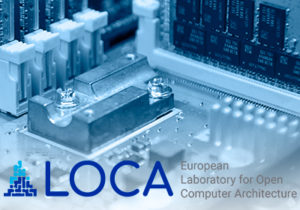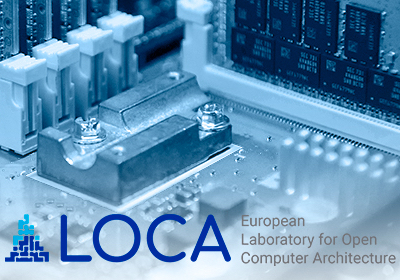 Today the Barcelona Supercomputing Center (BSC) announced the European Laboratory for Open Computer Architecture (LOCA). LOCA’s mission is to design and develop energy efficient and high performance chips, based on open architectures like RISC-V, OpenPOWER, and MIPS, in Europe, for use within future exascale supercomputers and other high performance domains.
Today the Barcelona Supercomputing Center (BSC) announced the European Laboratory for Open Computer Architecture (LOCA). LOCA’s mission is to design and develop energy efficient and high performance chips, based on open architectures like RISC-V, OpenPOWER, and MIPS, in Europe, for use within future exascale supercomputers and other high performance domains.
European Laboratory for Open Computing Architectures will be based in Barcelona and provide an ideal environment in a global center for the leading computer engineers and scientists from industry and academia to participate in the development and fabrication of open source systems, including open hardware, targeting a variety of different high performance software domains.
LOCA will be a collaborative laboratory that welcomes companies, foundations and academic institutions that share the vision that it is necessary to create open architectures to guarantee transparency, competitiveness and technological sovereignty”, said Prof Mateo Valero. “We are launching it with great conviction, because it is another step in our philosophy of paving the way for the creation of European HPC architectures, as we did in the past with the Montblanc project, creating a clusters based on ARM processors and we are currently doing in the EPI project by developing the general software stack and a RISC-V accelerator in the ARM-based multicore chip.”
Technology context
LOCA´s objectives start from a context in which the technology landscape is changing to one that is enabled by HPC and where traditional HPC workloads are being deployed in non-HPC environments. This has been driven by an exponential increase in data, analytics (AI, DL, and ML), requiring more powerful CPUs, new memory technologies, fast, cheap, and large storage and massive network bandwidth.
Unfortunately, not everything is improving and we must plan for the slowing of Moore’s Law, which has shifted the hardware landscape to one that uses specialization, currently in the form of emerging accelerators, to meet the increasing power and performance requirements of all applications, especially HPC applications.
Numerical computing accelerators, such as GPUs (Graphical Processing Units), or Field Programmable Gate Arrays (FPGA’s), are one of the key components allowing supercomputers to help solve some of humanity’s greatest challenges.
Open architectures enable hardware-software co-design to further specialize these systems and improve their efficiency and performance. This specialization will allow researchers and scientists that use supercomputers to get out more from them. For example, new architectures will allow to build more accurate models of the earth climate to understand global warming and study how to limit it, design new drugs with precision medicine to cure deadly diseases, understand the origin and evolution of the universe or design new energy efficient vehicles.
An open source software and hardware future
John D. Davis, who received his PhD from Stanford, is a former researcher with a focus on Computer Architecture and Systems at MSR in Silicon Valley, and held multiple technical roles in startups and large companies, will direct the European Laboratory for Open Computer Architecture. “We envision a future that is wide open, incorporating open source software and hardware”, says Davis. “LOCA is a mechanism to extend the success of OSS, like Linux, to the hardware domain. We can no longer rely on Moore´s Law for dramatic improvements in CPU performance. To unlock the potential energy efficiency and performance of future systems, we must use hardware/software co-design, enabled by an open hardware and open software ecosystem. LOCA´s inaugural five-year plan focuses on developing and building key open European-made IP as a basis for future Exascale and beyond systems.”
This is an exciting time to join LOCA and help shape the future of a full stack open computing ecosystem. Highly relevant institutions in the open architecture sector have already expressed their satisfaction with the initiative and their willingness to join it.
We are excited to see the commitment and support BSC is giving to RISC-V and the open source hardware community,” said Calista Redmond, CEO of the RISC-V Foundation. “We are looking forward to the many collaboration opportunities with LOCA to improve the open source hardware ecosystem and expand RISC-V into the HPC domain and beyond. This continues the leading edge work BSC has done in driving European innovation in HPC hardware, like in the EPI project, and the open source community, in general.”
Also, many companies and academic institutions have already expressed interest in participating in this shared vision and being part of LOCA as the catalyst for this global initiative, supported by leading industrial, academic and community members uniting behind this full stack effort to improve the maturity and breadth of open source hardware and its constituent open source software.
OpenPOWER Foundation has cultivated a broad-based ecosystem that has demonstrated leadership in HPC. As a long-standing member of the Foundation, BSC can leverage this collaborative ecosystem to advance LOCA’s objectives”, said Mendy Furmanek, OpenPOWER Foundation President. “With the recent opening of the POWER ISA, new innovations can be built on top of a versatile architecture with a mature, robust, and completely open system stack. This will give LOCA flexibility to purpose build the right hardware for the right application in an open, secure, and transparent way. OpenPOWER Foundation is enthusiastic about the opportunities LOCA will enable in the open ecosystem and congratulates BSC for championing this new initiative.”
Prof. Mateo Valero, Director of the Barcelona Supercomputing Center, will unveil more details of the project during a talk that will take place in Denver on November 20th, during the SC19 Supercomputing Conference.




